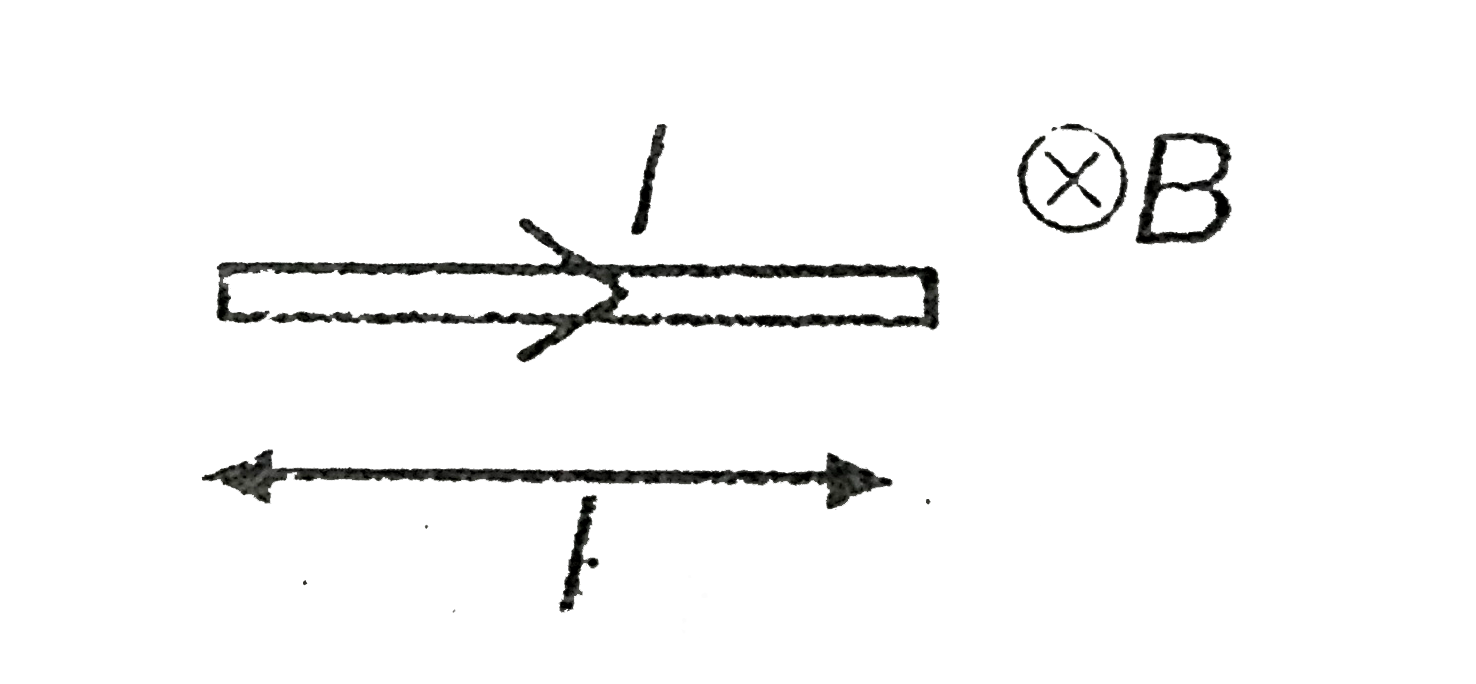A straight horizontal wire of mass 10mg and length 1.0 cm carries a current of 2.0 A. what minimum megnetic field B should be applied in the region so that the magnetic force on the wire may balance its weight?
To solve the problem, we need to find the minimum magnetic field B that will balance the weight of the wire with the magnetic force acting on it. Let's break down the solution step by step.
Step 1: Calculate the weight of the wire
The weight W of the wire can be calculated using the formula:
W=mg
where:
- m is the mass of the wire,
- g is the acceleration due to gravity (approximately 10m/s2).
Given:
- Mass m=10mg=10×10−3g=10×10−6kg.
Now substituting the values:
W=(10×10−6kg)(10m/s2)=10×10−5N=10−4N
Step 2: Write the expression for the magnetic force
The magnetic force Fm acting on a current-carrying wire in a magnetic field is given by:
Fm=I⋅L⋅B
where:
- I is the current (2.0 A),
- L is the length of the wire (1.0 cm = 1.0×10−2m),
- B is the magnetic field strength.
Step 3: Set the magnetic force equal to the weight
To balance the weight of the wire, we set the magnetic force equal to the weight:
I⋅L⋅B=W
Substituting the known values:
(2.0A)⋅(1.0×10−2m)⋅B=10−4N
Step 4: Solve for the magnetic field B
Rearranging the equation to solve for B:
B=WI⋅L
Substituting the values:
B=10−4N(2.0A)⋅(1.0×10−2m)
Calculating the denominator:
B=10−42.0×10−2=10−42×10−2=10−42×10−2=10−42×10−2=10−42×10−2=10−22=5×10−3T
Final Answer
Thus, the minimum magnetic field B required to balance the weight of the wire is:
B=5T
The weight W of the wire can be calculated using the formula:
W=mg
where:
- m is the mass of the wire,
- g is the acceleration due to gravity (approximately 10m/s2).
- Mass m=10mg=10×10−3g=10×10−6kg.
W=(10×10−6kg)(10m/s2)=10×10−5N=10−4N
The magnetic force Fm acting on a current-carrying wire in a magnetic field is given by:
Fm=I⋅L⋅B
where:
- I is the current (2.0 A),
- L is the length of the wire (1.0 cm = 1.0×10−2m),
- B is the magnetic field strength.
To balance the weight of the wire, we set the magnetic force equal to the weight:
I⋅L⋅B=W
(2.0A)⋅(1.0×10−2m)⋅B=10−4N
Rearranging the equation to solve for B:
B=WI⋅L
Substituting the values:
B=10−4N(2.0A)⋅(1.0×10−2m)
Calculating the denominator:
B=10−42.0×10−2=10−42×10−2=10−42×10−2=10−42×10−2=10−42×10−2=10−22=5×10−3T
Thus, the minimum magnetic field B required to balance the weight of the wire is:
B=5T
Topper's Solved these Questions
- MAGNETIC FIELDBOOK - HC VERMA ENGLISHCHAPTER - MAGNETIC FIELDEXERCISE - QUESTIONS FOR SHORT ASNWER
10 Videos
- MAGNETIC FIELDBOOK - HC VERMA ENGLISHCHAPTER - MAGNETIC FIELDEXERCISE - objective2
9 Videos
- MAGNETIC FIELDBOOK - HC VERMA ENGLISHCHAPTER - MAGNETIC FIELDEXERCISE - objective 1
10 Videos
- LIGHT WAVESBOOK - HC VERMA ENGLISHCHAPTER - LIGHT WAVESEXERCISE - Question for short Answer
11 Videos
- MAGNETIC FIELD DUE TO CURRENTBOOK - HC VERMA ENGLISHCHAPTER - MAGNETIC FIELD DUE TO CURRENTEXERCISE - questions for short answer
12 Videos
Similar Questions
A straight wire of mass 200 g and length 1.5 m carries a current of 2 A. It is suspended in mid-air by a uniform horizontal magnetic field B. What is the magnitude of the magnetic field?

View SolutionA straight wire of mass 200 g and length 1.5 m carries a current of 2 A. It is suspended in mid-air by a uniform horizontal magnetic field B. What is the magnitude of the magnetic field?

View Solution
Knowledge Check
A straight wire having mass of 1.2 kg and length of 1m carries a current of 5 A. If the wire is suspended in mid-air by a uniform horizontal magnetic field, then the magnitude of field is
A0.65TB1.53TC2.4TD3.2T
A straight wire of mass 200 g and length 1.5 m carries a current of 2 A. It is suspended in mid-air by a uniform horizontal magnetic field B. What is the magnitude of the magnetic field?

View SolutionA straight wire of mass 400 g and length 2m carries a current of 2A. It is suspended in mid air by a uniform horizontal field B. What is the magnitude of the magnetic field ?

View SolutionA straight wire of mass 400 g and length 2m carries a current of 2A. It is suspended in mid air by a uniform horizontal field B. What is the magnitude of the magnetic field ?

View SolutionA wire of mass 100 g, length 1 m and current 5 A is balanced in mid air by a magnetic field B, then find the value of B.
View SolutionA straight horizontal conductor of length L meter and mass mkg carries a current 'I' ampere. The minimum magnetic induction which must exist in the region to balance its weight
View SolutionA wire of length L carries a current i along the x-axis. A magnetic field B=B0(ˆi+ˆj+ˆk) exists in the space. Find the magnitude of the magnetic force acting on the wire.
View SolutionA semicircular wire of radius 5.0 cm carries a current of 5.0 A. A magnetic field B of magnitude 0.50 T exists along the perpendicular to the plane of the wire. Find the magnitude of the magnetic force acting on the wire.
View Solution
